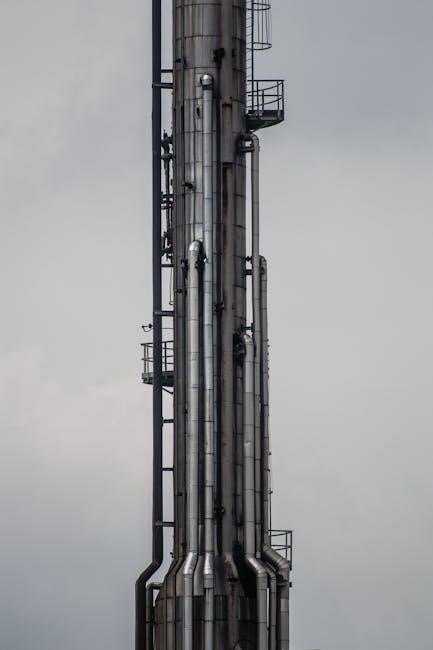Toddlers need iron-rich foods for healthy growth and brain development. Iron deficiency is common due to high growth demands and limited dietary intake. Include meats, leafy greens, and fortified cereals, and pair with vitamin C-rich foods to boost absorption. Ensuring adequate iron intake supports energy levels and overall well-being in young children.
1.1. Importance of Iron for Toddler Growth and Development
Iron is essential for toddlers’ rapid growth and brain development. It supports oxygen transport in the blood, enabling energy production and healthy cell function. Iron deficiency can lead to anemia, causing fatigue, pale skin, and delayed development. Adequate iron intake promotes cognitive skills, motor development, and a strong immune system. During toddlerhood, iron is critical for brain maturation and physical growth, making it a cornerstone of a balanced diet. Ensuring sufficient iron helps prevent developmental delays and supports overall health, fostering active and curious minds in young children.
1.2. Consequences of Iron Deficiency in Toddlers
Iron deficiency in toddlers can lead to anemia, causing fatigue, pale skin, and shortness of breath. It impairs cognitive development, memory, and attention span, potentially affecting academic performance later. Motor skills may delay, and the immune system weakens, increasing illness susceptibility. Severe deficiency can stunt growth and development. If untreated, iron-deficiency anemia may result in long-term health issues, emphasizing the need for early detection and dietary interventions to ensure optimal health and developmental milestones in young children.

Categories of Iron-Rich Foods for Toddlers
Iron-rich foods for toddlers include haem iron sources like meats and poultry, non-haem iron from plants like spinach, and fortified cereals, ensuring diverse dietary options.
2.1. Animal-Based Sources of Iron (Haem Iron)
Animal-based foods are rich in haem iron, the most easily absorbed form of iron. Meats like beef, chicken, and turkey, as well as organs such as liver, are excellent sources. Egg yolks also contribute to haem iron intake. These foods are particularly beneficial for toddlers, as they support rapid growth and brain development. Including a variety of animal-based iron sources in meals helps meet daily iron requirements and reduces the risk of deficiency. Pairing these foods with vitamin C-rich options can further enhance absorption.
2.2. Plant-Based Sources of Iron (Non-Haem Iron)
Plant-based foods provide non-haem iron, which is less easily absorbed than haem iron but still essential for toddlers. Dark green leafy vegetables like spinach, kale, and broccoli are rich in iron. Legumes, such as lentils, chickpeas, and black beans, are also excellent sources. Whole grains, like quinoa and brown rice, contribute to iron intake. Pairing these foods with vitamin C-rich options, such as tomatoes or bell peppers, enhances absorption. While plant-based iron requires more planning, including a variety of these foods in meals ensures toddlers meet their dietary needs and supports healthy growth and development.

2.3; Fortified Foods for Toddlers
Fortified foods are a reliable way to boost iron intake in toddlers, especially when natural sources are insufficient. Iron-fortified cereals, often the first foods introduced, are rich in haem iron. Baby formulas and porridges also contain added iron. Many breads and pastas are enriched with iron, making them nutritious staples. These foods are specifically designed to meet toddlers’ high iron needs during rapid growth. Parents can trust fortified options to ensure their child gets adequate iron, supporting energy levels and brain development without relying solely on whole foods. This makes them a practical choice for busy families.

Enhancing Iron Absorption in Toddlers
Boost iron absorption by pairing iron-rich foods with vitamin C-rich foods like citrus fruits or tomatoes. Avoid iron-absorption inhibitors such as tea, coffee, and dairy products.
3.1. Role of Vitamin C in Iron Absorption
Vitamin C plays a crucial role in enhancing non-haem iron absorption by converting it into a more soluble form. Foods like citrus fruits, tomatoes, and strawberries, rich in vitamin C, can significantly boost iron uptake when consumed alongside iron-rich foods. This natural pairing helps toddlers maximize iron benefits, supporting healthy growth and development.

3;2. Foods to Avoid for Better Iron Absorption
Certain foods can hinder iron absorption, such as tea, coffee, and dairy products. These contain compounds like tannins and calcium that reduce iron uptake. Parents should limit these during meals rich in iron. Additionally, offering iron-rich foods separately from these inhibitors can help maximize absorption and ensure toddlers meet their nutritional needs for optimal growth and health. Balancing meals appropriately supports better iron utilization in young children.

Common High Iron Foods for Toddlers
- Meats, poultry, and liver
- Dark leafy greens like spinach
- Beans, lentils, and fortified cereals
4.1. Meats and Poultry
Meats and poultry are excellent sources of haem iron, the most easily absorbed form of iron. Red meat, chicken, and turkey are rich in iron, while organ meats like liver offer exceptionally high levels. These foods are ideal for toddlers, as they provide essential nutrients for growth and energy. Pairing meats with vitamin C-rich foods enhances iron absorption, making them a nutritious and practical choice for toddler meals. Including lean meats and poultry regularly ensures toddlers meet their daily iron needs, supporting healthy development and preventing deficiency risks. These foods are versatile and can be prepared in toddler-friendly ways.
4.2. Dark Green Leafy Vegetables
Dark green leafy vegetables are rich in non-haem iron, making them a valuable addition to a toddler’s diet. Spinach, kale, and broccoli are excellent choices, offering both iron and essential vitamins. These vegetables can be steamed, pureed, or mixed into meals for easy consumption. Pairing them with vitamin C-rich foods, like tomatoes or citrus, enhances iron absorption. Incorporating leafy greens into toddler meals supports overall health and energy levels, helping to meet their developmental needs. They are also versatile and can be prepared in ways that appeal to picky eaters, ensuring a balanced and nutritious diet.
4.3. Iron-Rich Grains and Cereals
Iron-rich grains and cereals are a convenient and nutritious way to boost a toddler’s iron intake. Fortified cereals, oatmeal, and quinoa are excellent sources of non-haem iron. These foods are often enriched with essential nutrients, making them a great option for young children. Whole grain options like brown rice and barley also provide iron and fibre. Pairing these grains with vitamin C-rich foods, such as berries or tomatoes, enhances iron absorption. They are easy to incorporate into meals and snacks, offering a versatile way to support a toddler’s growth and energy needs while promoting healthy eating habits from an early age.

Tips for Parents to Encourage Iron-Rich Diets
Parents can promote iron-rich diets by combining iron-rich foods with vitamin C sources, offering varied meals, and setting a positive example. Consistency and creativity are key to fostering healthy eating habits in toddlers.
5.1. Combining Iron-Rich Foods with Vitamin C-Rich Foods
Combining iron-rich foods with vitamin C-rich foods enhances iron absorption. Pair meats like chicken or beef with bell peppers or tomatoes. Serve spinach or beans alongside oranges or strawberries. This strategy boosts non-haem iron absorption, essential for toddlers. Avoid pairing iron-rich foods with tea, coffee, or dairy, as they hinder absorption. Encourage variety by adding citrus fruits or broccoli to meals. This simple yet effective method ensures toddlers maximize iron intake, supporting healthy growth and energy levels. Parents can easily incorporate this practice into daily meals for better nutritional benefits.
5.2. Managing Picky Eating in Toddlers
Toddlers often exhibit picky eating habits, making it challenging to ensure they consume enough iron-rich foods. Parents can offer small portions of iron-rich foods like meats, beans, or spinach alongside familiar favorites. Mixing finely chopped iron-rich foods into sauces, soups, or mashed dishes can help increase intake without overwhelming the child. Offering a variety of textures and flavors encourages exploration. Involving toddlers in meal preparation, such as letting them help with simple tasks, can also spark their interest in trying new foods. Patience and consistency are key to fostering healthy eating habits in young children.

Iron Requirements for Toddlers
Toddlers need about 7mg of iron daily for healthy growth and development. Iron deficiency can lead to fatigue, poor appetite, and delayed growth.
6.1. Recommended Daily Intake of Iron
Toddlers aged 1 to 3 years require approximately 7 milligrams of iron daily to support rapid growth and brain development. This essential nutrient helps produce hemoglobin, which carries oxygen in the blood. Insufficient intake can lead to iron deficiency, causing fatigue, pale skin, and developmental delays. Meeting this daily recommendation is crucial for maintaining energy levels and overall health in young children. Parents should focus on nutrient-rich diets that include iron-rich foods, paired with vitamin C sources to enhance absorption and ensure optimal iron levels.
6.2. Signs of Iron Deficiency to Watch For
Iron deficiency in toddlers often presents with noticeable symptoms. Fatigue, pale skin, and shortness of breath are common indicators. Developmental delays, poor appetite, and frequent infections may also occur. In severe cases, children might experience irritability, weakness, or difficulty concentrating. Parents should monitor these signs and consult a pediatrician if they persist. Early detection and dietary adjustments can prevent long-term effects on growth and cognitive development, ensuring toddlers thrive with adequate iron levels and overall health.

Practical Meal Ideas for Toddlers
Offer iron-rich meals like scrambled eggs with spinach, chicken with sweet potatoes, or lentils with diced oranges. These balanced options promote healthy growth and development.
7.1. Breakfast Options
Start the day with iron-rich breakfasts like fortified cereals paired with sliced strawberries or orange wedges. Serve scrambled eggs with spinach or tomatoes for a nutritious boost. Offer whole-grain toast with avocado or a side of prune puree. Introduce iron-fortified oatmeal mixed with berries for added vitamin C. These options provide essential nutrients and energy for active toddlers. Ensure breakfast includes a variety of textures and flavors to keep meals engaging and promote healthy eating habits from an early age.
7.2. Lunch and Snack Ideas
For lunch, offer iron-rich options like turkey or chicken wraps with spinach, or lentil soup with whole-grain crackers. Snacks can include hummus with sliced cucumbers or bell peppers, both rich in vitamin C to enhance iron absorption. Serve fortified crackers or cheese for quick, nutritious options. Mini sandwiches with lean meats or avocado are also great choices. Incorporate iron-fortified snacks like puffed rice or cornflakes. Pairing iron-rich foods with vitamin C-rich fruits like strawberries or oranges boosts absorption. These ideas provide balanced nutrition and variety for toddlers’ meals and snacks.
Ensuring toddlers consume iron-rich foods is vital for their growth and development. Combining iron sources with vitamin C-rich foods enhances absorption, supporting healthy brain and physical development.
8.1. Summary of Key Points
Iron is crucial for toddlers’ growth, brain development, and preventing deficiency. Include animal sources like meats and poultry, plant-based options like leafy greens, and fortified cereals. Pair iron-rich foods with vitamin C-rich foods to enhance absorption. Avoid iron-absorption inhibitors like dairy and tea. Monitor for deficiency signs such as fatigue or pale skin. Practical meal ideas and consistent dietary habits ensure adequate intake. Parents should stay vigilant, as iron deficiency can impact cognitive and motor skills. Regularly incorporating these foods supports overall health and development in toddlers.
8.2. Final Tips for Parents
Parents should prioritize iron-rich foods, pairing them with vitamin C sources to maximize absorption. Offer a variety of options like meats, leafy greens, and fortified cereals. Involve toddlers in meal preparation to spark interest. Stay patient with picky eaters and ensure consistent iron intake. Monitor for signs of deficiency and consult a pediatrician if concerns arise. Regularly introducing iron-rich meals and maintaining a balanced diet supports long-term health and development. Consistency and vigilance are key to preventing iron deficiency in toddlers.